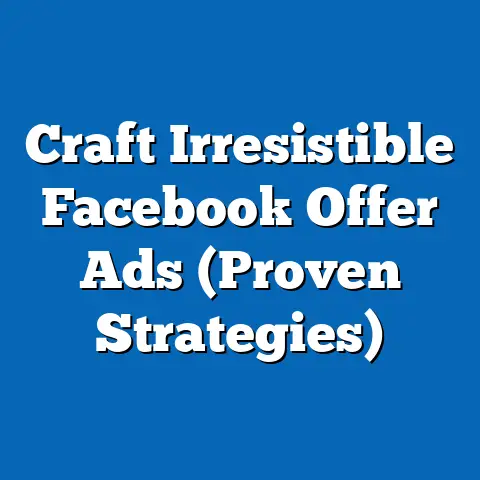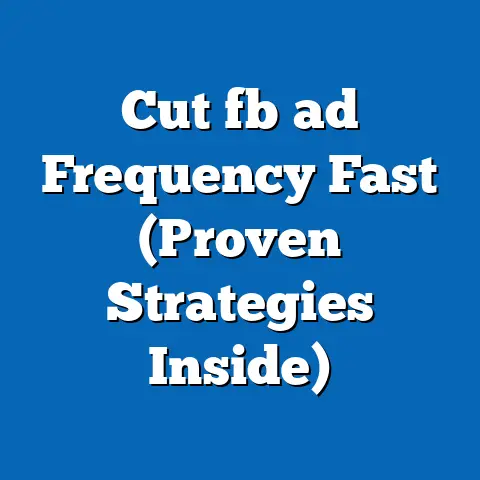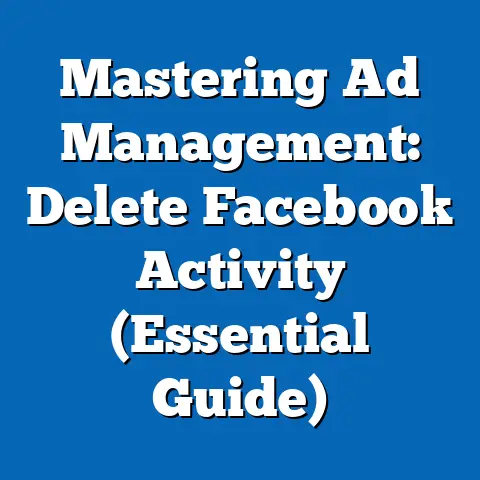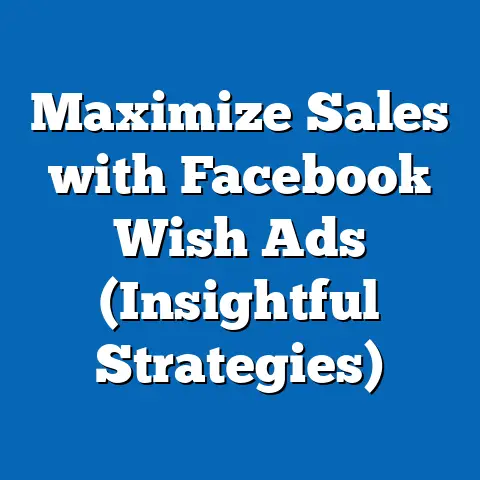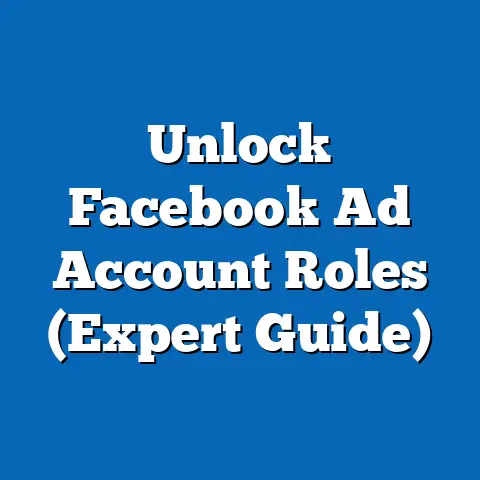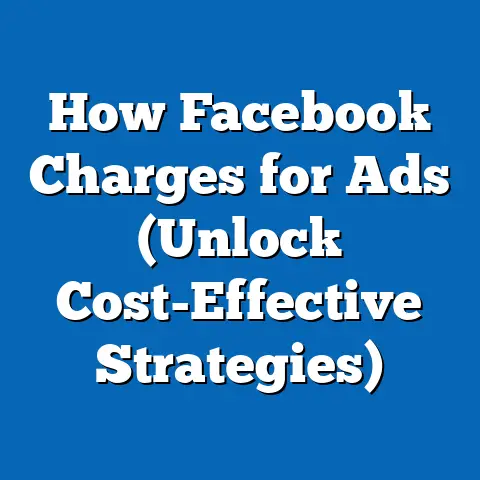Unlock Facebook Ads Mastery (Expert Guide Inside)
Have you ever watched one of those home renovation shows and been completely captivated? I know I have! There’s something incredibly satisfying about seeing a dilapidated space transform into a beautiful, functional home. But behind every stunning reveal is a lot of careful planning, creative problem-solving, and the right tools. Think of digital marketing as a similar kind of renovation – a chance to revamp your brand’s online presence and build a thriving business. And just like a power saw is essential for a contractor, Facebook Ads is a powerful tool that can help you achieve transformative results.
Facebook Ads, when wielded correctly, can be the wrecking ball that tears down marketing barriers and the skilled craftsman that builds a robust customer base. But just as a poorly planned renovation can lead to costly mistakes and endless headaches, diving into Facebook Ads without a solid understanding of the fundamentals can be equally frustrating. You might face challenges like blowing your budget on the wrong audience, struggling to create ads that capture attention, or simply not seeing the return on investment you hoped for.
Section 1: Understanding Facebook Ads
Before you start hammering nails and tearing down walls, it’s crucial to understand the underlying structure of Facebook Ads. Think of it as learning the difference between a stud and a joist before you start building! This section breaks down the fundamentals, giving you a solid foundation to build upon.
The Building Blocks: Campaigns, Ad Sets, and Ads
The Facebook Ads Manager is organized into three primary levels:
- Campaigns: This is the highest level, where you define your overall advertising objective. Are you trying to increase brand awareness, drive traffic to your website, generate leads, or boost sales? Your campaign objective will influence the types of ads you create and the targeting options you choose.
- Ad Sets: Within each campaign, you create ad sets. Ad sets are where you define your target audience, budget, schedule, and ad placements. You can create multiple ad sets within a single campaign to target different audience segments or test different bidding strategies.
- Ads: This is the actual creative content that your audience sees. Each ad set contains one or more ads, which can be images, videos, carousels, or other formats. It’s important to test different ad variations to see what resonates best with your target audience.
Think of it like this: the Campaign is the overall renovation project (e.g., “Kitchen Remodel”). The Ad Set is a specific aspect of the renovation (e.g., “New Countertops”), defining the budget, materials, and contractor (target audience) for that part. And the Ad is the actual visual representation of the new countertops, showcasing the style, color, and benefits.
My Experience: I remember when I first started using Facebook Ads, I was so focused on the creative aspects that I completely overlooked the importance of structuring my campaigns properly. I threw all my ads into a single campaign with a broad audience, and unsurprisingly, my results were terrible. It wasn’t until I took the time to understand the hierarchy of campaigns, ad sets, and ads that I started to see a real improvement in my performance.
Setting Clear Objectives: Aligning Ads with Business Goals
Before you spend a single dollar on advertising, it’s essential to define your objectives. What do you want to achieve with your Facebook Ads? Are you trying to:
- Increase Brand Awareness: Reach a large audience and introduce your brand to potential customers.
- Drive Traffic to Your Website: Get people to visit your website and learn more about your products or services.
- Generate Leads: Collect contact information from potential customers who are interested in your offerings.
- Boost Sales: Drive direct sales of your products or services through online or offline channels.
- Increase Engagement: Encourage people to like, comment, share, and interact with your content.
- Promote an App: Drive app installs and engagement.
Choosing the right objective is crucial because it tells Facebook’s algorithm what you’re trying to achieve. The algorithm will then optimize your ads to reach people who are most likely to take the desired action.
Expert Insight: According to Facebook, campaigns with clear, well-defined objectives are more likely to achieve their goals. In fact, campaigns that align with specific business outcomes can see up to a 30% improvement in results.
Practical Tip: Don’t just choose an objective at random. Take the time to analyze your business goals and determine which objective aligns best with your overall marketing strategy. For example, if you’re launching a new product, you might start with a brand awareness campaign to build buzz and then transition to a conversion campaign to drive sales.
Navigating the Facebook Advertising Ecosystem
Facebook’s advertising ecosystem is vast and constantly evolving. It includes a variety of ad formats and placements that you can use to reach your target audience.
Ad Formats:
- Image Ads: Simple and effective for showcasing products or services with a single image.
- Video Ads: Engaging and versatile for telling stories, demonstrating products, or sharing testimonials.
- Carousel Ads: Allow you to showcase multiple products or features in a single ad unit.
- Collection Ads: Designed for mobile shopping, featuring a hero image or video with related products below.
- Instant Experience Ads: Full-screen, mobile-optimized ads that provide an immersive experience.
- Lead Ads: Designed to collect contact information from potential customers directly within Facebook.
Ad Placements:
- Facebook Feed: The main newsfeed on Facebook, where users see updates from friends, family, and businesses.
- Instagram Feed: The main newsfeed on Instagram, similar to the Facebook feed.
- Facebook Marketplace: A platform for buying and selling goods within Facebook.
- Facebook Stories: Short-form video or image content that disappears after 24 hours.
- Instagram Stories: Similar to Facebook Stories, but on Instagram.
- Facebook Right Column: Ads that appear in the right-hand column of the Facebook desktop site.
- Audience Network: A network of third-party websites and apps where Facebook ads can be displayed.
- Messenger: Ads that appear within the Messenger app.
My Insight: Don’t be afraid to experiment with different ad formats and placements to see what works best for your business. I’ve found that video ads tend to perform well on Instagram, while carousel ads are great for showcasing multiple products on Facebook.
Key Takeaway: Understanding the fundamentals of Facebook Ads – the structure, objectives, and ecosystem – is crucial for building a successful advertising strategy. Take the time to learn these concepts before you start creating ads, and you’ll be well on your way to achieving your marketing goals.
Next Steps: Familiarize yourself with the Facebook Ads Manager interface. Explore the different campaign objectives, ad formats, and placements. Start thinking about how these elements can be used to achieve your specific business goals.
Section 2: Crafting the Perfect Ad
Think of your Facebook ad as the curb appeal of your business. It’s the first impression you make on potential customers, and it needs to be attention-grabbing and inviting. Just like a fresh coat of paint and a well-manicured lawn can make a house stand out, a well-crafted ad can capture attention and drive results.
The Three Pillars: Headlines, Visuals, and CTAs
A successful Facebook ad typically consists of three key elements:
- Attention-Grabbing Headlines: Your headline is the first thing people see, so it needs to be compelling and relevant. Use strong verbs, numbers, and questions to pique interest.
- Engaging Visuals: Images and videos are crucial for capturing attention and conveying your message. Use high-quality visuals that are relevant to your target audience and your ad copy.
- Compelling Calls to Action (CTAs): Your CTA tells people what you want them to do next. Use clear and concise language that encourages action, such as “Shop Now,” “Learn More,” or “Sign Up.”
Example: Let’s say you’re advertising a new line of organic skincare products.
- Headline: “Discover Radiant Skin with Our New Organic Skincare Line”
- Visual: A high-quality image of a person with glowing skin using your product.
- CTA: “Shop Now and Get 15% Off Your First Order”
Expert Insight: According to a study by HubSpot, personalized CTAs perform 202% better than generic CTAs. Tailor your CTAs to your target audience and the specific offer you’re promoting.
Creating High-Quality Visuals and Videos
Visuals are the heart of your Facebook ad. They’re what capture people’s attention and draw them in. Here are some tips for creating high-quality visuals and videos:
- Use High-Resolution Images: Avoid blurry or pixelated images. Use high-resolution images that are clear and sharp.
- Choose Relevant Images: Make sure your images are relevant to your target audience and your ad copy.
- Use Eye-Catching Colors: Use colors that are visually appealing and that stand out from the Facebook feed.
- Create Short and Engaging Videos: Keep your videos short and to the point. Focus on delivering your message quickly and effectively.
- Use Captions: Many people watch videos on Facebook with the sound off, so it’s important to use captions to convey your message.
- Optimize for Mobile: Make sure your visuals and videos are optimized for mobile devices, as most people access Facebook on their phones.
My Experience: I once ran a Facebook ad campaign for a local restaurant using low-quality, blurry images of their food. The results were terrible. As soon as I replaced the images with professional, high-resolution photos, my click-through rates skyrocketed. The difference was night and day!
The Psychology of Persuasive Ad Copy
Your ad copy is just as important as your visuals. It’s what tells people why they should care about your product or service. Here are some tips for writing persuasive ad copy:
- Use Storytelling: Tell a story that resonates with your target audience. People are more likely to remember and connect with a story than a list of features.
- Use Emotional Triggers: Tap into your audience’s emotions by highlighting the benefits of your product or service. For example, if you’re selling a weight loss program, you might focus on the emotions of confidence, health, and happiness.
- Use Social Proof: Show that other people have had positive experiences with your product or service. Include testimonials, reviews, or case studies in your ad copy.
- Highlight Benefits, Not Just Features: Focus on how your product or service will improve your customers’ lives, rather than just listing its features.
- Use Clear and Concise Language: Avoid jargon and technical terms. Use language that is easy to understand and that speaks directly to your target audience.
- Create a Sense of Urgency: Encourage people to take action by creating a sense of urgency. Use phrases like “Limited Time Offer” or “While Supplies Last.”
Practical Tip: Before you write your ad copy, take the time to understand your target audience’s needs, desires, and pain points. What are they looking for? What problems are they trying to solve? Use this knowledge to craft ad copy that resonates with them on a personal level.
Key Takeaway: Crafting the perfect Facebook ad is a combination of art and science. It requires a deep understanding of your target audience, a creative eye for visuals, and a knack for persuasive writing. By focusing on the three pillars of headlines, visuals, and CTAs, you can create ads that capture attention, engage your audience, and drive results.
Next Steps: Experiment with different ad formats, visuals, and ad copy variations. Use A/B testing to see what resonates best with your target audience. Track your results and make adjustments as needed.
Section 3: Targeting the Right Audience
Imagine you’re a contractor building a custom home. You wouldn’t use the same blueprints for a beachfront property as you would for a mountain cabin, right? Similarly, you need to tailor your Facebook ads to reach the right audience. Targeting is the key to ensuring your message resonates with the people who are most likely to be interested in your products or services.
Exploring Facebook’s Audience Targeting Options
Facebook offers a wide range of audience targeting options, allowing you to reach specific groups of people based on their demographics, interests, behaviors, and connections.
- Demographic Targeting: Target people based on their age, gender, location, education, job title, and other demographic information.
- Interest Targeting: Target people based on their interests, hobbies, and activities. Facebook gathers this information from the pages people like, the groups they join, and the topics they discuss.
- Behavior Targeting: Target people based on their online behavior, such as their purchase history, device usage, and travel habits.
- Custom Audiences: Target people who have already interacted with your business, such as website visitors, email subscribers, or customers.
- Lookalike Audiences: Create audiences that are similar to your existing customers or website visitors. This is a powerful way to reach new people who are likely to be interested in your products or services.
Example: Let’s say you’re selling organic baby food. You could target parents with young children using demographic targeting, people interested in organic food and baby products using interest targeting, and people who have visited your website or purchased from you in the past using custom audiences.
Expert Insight: According to Facebook, businesses that use custom audiences see a 20% increase in website conversions and a 30% increase in sales.
The Significance of Audience Segmentation
Audience segmentation involves dividing your target audience into smaller, more specific groups based on shared characteristics. This allows you to create more targeted ads that resonate with each segment.
- Segment by Demographics: Create separate ad sets for different age groups, genders, or locations.
- Segment by Interests: Create separate ad sets for people interested in different topics or hobbies.
- Segment by Behaviors: Create separate ad sets for people who have different online behaviors or purchase histories.
- Segment by Customer Journey Stage: Create separate ad sets for people who are at different stages of the customer journey, such as awareness, consideration, or decision.
My Experience: I once worked with a client who was selling a high-end fitness program. Initially, they were targeting a broad audience of people interested in fitness. However, after segmenting their audience by age and income, we discovered that their ideal customer was a woman between the ages of 35 and 55 with a household income of $100,000 or more. By focusing our targeting on this specific segment, we were able to significantly improve our conversion rates.
Creating Buyer Personas
A buyer persona is a fictional representation of your ideal customer. It’s based on research and data about your existing customers and target audience. Creating buyer personas can help you refine your targeting strategies and create more relevant and engaging ads.
- Give Your Persona a Name and Background: Create a name, age, location, job title, and other demographic information for your persona.
- Identify Their Goals and Challenges: What are they trying to achieve? What problems are they trying to solve?
- Understand Their Motivations and Values: What motivates them to make a purchase? What values are important to them?
- Determine Their Online Behavior: Where do they spend their time online? What websites do they visit? What social media platforms do they use?
- Identify Their Pain Points: What are their biggest frustrations? What are they struggling with?
Example: Let’s say you’re selling a project management software. Your buyer persona might be “Sarah, the Small Business Owner.” Sarah is 35 years old, lives in a suburban area, and owns a small marketing agency. She’s overwhelmed with managing multiple projects and clients, and she’s looking for a software solution that can help her streamline her workflow and improve her team’s productivity.
The Role of A/B Testing in Audience Targeting
A/B testing involves testing different variations of your ads and targeting options to see what performs best. This is a crucial step in optimizing your campaigns and ensuring you’re reaching the right audience.
- Test Different Targeting Options: Create separate ad sets for different demographic, interest, or behavior targeting options.
- Test Different Ad Creatives: Create different ad variations with different headlines, visuals, and ad copy.
- Track Your Results: Use Facebook Ads Manager to track the performance of each ad set and ad variation.
- Analyze Your Data: Identify which targeting options and ad creatives are performing best.
- Optimize Your Campaigns: Focus your budget on the targeting options and ad creatives that are driving the best results.
Practical Tip: Don’t try to test too many variables at once. Focus on testing one or two variables at a time to ensure you can accurately measure the impact of each change.
Key Takeaway: Targeting the right audience is crucial for Facebook Ads success. By exploring Facebook’s audience targeting options, segmenting your audience, creating buyer personas, and using A/B testing, you can ensure your ads are reaching the people who are most likely to be interested in your products or services.
Next Steps: Start experimenting with different audience targeting options in Facebook Ads Manager. Create buyer personas for your ideal customers. Use A/B testing to optimize your targeting strategies and ad creatives.
Section 4: Budgeting and Bidding Strategies
Just like a home renovation project needs a well-defined budget to avoid running out of funds halfway through, your Facebook Ads campaign needs a carefully planned budget and bidding strategy. This section will help you understand how to set an effective budget and choose the right bidding strategy to maximize your return on investment.
Setting an Effective Budget
Setting the right budget for your Facebook Ads campaign can feel like a balancing act. You want to spend enough to reach your target audience and achieve your objectives, but you don’t want to overspend and waste money. Here are some factors to consider when setting your budget:
- Your Business Goals: What do you want to achieve with your Facebook Ads? Are you trying to increase brand awareness, drive traffic to your website, generate leads, or boost sales? Your budget should align with your goals.
- Your Target Audience: How large is your target audience? The larger your audience, the more you’ll need to spend to reach them effectively.
- Your Industry: Some industries are more competitive than others. If you’re in a competitive industry, you may need to spend more to stand out from the crowd.
- Your Ad Relevance: The more relevant your ads are to your target audience, the lower your costs will be.
- Your Bidding Strategy: The bidding strategy you choose will affect how much you pay for each click or impression.
Facebook offers two main types of budgets:
- Daily Budget: The average amount you’re willing to spend each day.
- Lifetime Budget: The total amount you’re willing to spend over the entire duration of your campaign.
My Experience: When I first started using Facebook Ads, I made the mistake of setting a daily budget that was too low. As a result, my ads weren’t reaching enough people, and I wasn’t seeing the results I wanted. Once I increased my daily budget, my performance improved significantly.
Understanding CPC vs. CPM
Before we dive deeper into budgeting, it’s crucial to understand the difference between two key cost metrics:
- Cost Per Click (CPC): The amount you pay each time someone clicks on your ad.
- Cost Per Thousand Impressions (CPM): The amount you pay for every 1,000 times your ad is shown.
Which metric is right for you depends on your campaign objective. If you’re trying to drive traffic to your website or generate leads, CPC might be a better choice. If you’re trying to increase brand awareness, CPM might be more effective.
Expert Insight: According to WordStream, the average CPC for Facebook Ads is around \$1.72, while the average CPM is around \$11.20. However, these numbers can vary depending on your industry, target audience, and ad relevance.
Choosing the Right Bidding Strategy
Facebook offers a variety of bidding strategies to help you achieve your campaign objectives. The right bidding strategy will depend on your goals, budget, and target audience.
- Automatic Bidding: Facebook automatically sets your bids to get the most results for your budget. This is a good option for beginners or for campaigns with a limited budget.
- Manual Bidding: You set your bids manually, giving you more control over how much you pay for each click or impression. This is a good option for experienced advertisers who want to optimize their campaigns for specific goals.
Within manual bidding, you have several options:
- Cost Per Click (CPC) Bidding: You bid on each click.
- Cost Per Thousand Impressions (CPM) Bidding: You bid on every 1,000 impressions.
- Cost Per Action (CPA) Bidding: You bid on specific actions, such as conversions or app installs.
Practical Tip: Start with automatic bidding to get a sense of what the average costs are for your target audience and industry. Then, once you have enough data, you can switch to manual bidding to optimize your campaigns for specific goals.
Analyzing Return on Ad Spend (ROAS)
Return on Ad Spend (ROAS) is a key metric for measuring the profitability of your Facebook Ads campaigns. It tells you how much revenue you’re generating for every dollar you spend on advertising.
The formula for calculating ROAS is:
ROAS = (Revenue Generated from Ads / Cost of Ads) x 100
For example, if you spend \$100 on Facebook Ads and generate \$500 in revenue, your ROAS would be:
ROAS = (\$500 / \$100) x 100 = 500%
This means you’re generating \$5 in revenue for every dollar you spend on advertising.
My Experience: I once worked with a client who wasn’t tracking their ROAS. They were spending a lot of money on Facebook Ads, but they had no idea if it was actually generating a positive return. Once we started tracking ROAS, we discovered that some of their campaigns were highly profitable, while others were losing money. We were able to reallocate their budget to the profitable campaigns and significantly improve their overall ROI.
Adjusting Budgets Based on Performance Metrics
It’s important to continuously monitor your campaign performance and adjust your budgets based on the data you’re seeing. If a campaign is performing well, you might want to increase your budget to reach more people. If a campaign is underperforming, you might want to decrease your budget or pause the campaign altogether.
Key Takeaway: Setting an effective budget and choosing the right bidding strategy are crucial for maximizing your return on investment with Facebook Ads. By considering your business goals, target audience, industry, and ad relevance, you can set a budget that aligns with your objectives. By understanding CPC vs. CPM and experimenting with different bidding strategies, you can optimize your campaigns for specific goals. And by tracking ROAS and adjusting your budgets based on performance metrics, you can ensure you’re getting the most out of your advertising spend.
Next Steps: Start tracking your ROAS for your Facebook Ads campaigns. Experiment with different bidding strategies to see what works best for your business. Continuously monitor your campaign performance and adjust your budgets based on the data you’re seeing.
Section 5: Analyzing and Optimizing Campaigns
Imagine you’ve finished a home renovation project. You wouldn’t just walk away without inspecting the quality of the work, right? You’d check the paint job, make sure the appliances are working, and ensure everything is functioning as it should. Similarly, you need to continuously analyze and optimize your Facebook Ads campaigns to ensure they’re performing at their best.
The Importance of Tracking Ad Performance
Tracking ad performance is essential for understanding what’s working and what’s not. By monitoring key metrics, you can identify areas for improvement and optimize your campaigns to achieve better results.
Facebook Ads Manager provides a wealth of data about your ad performance, including:
- Impressions: The number of times your ad was shown.
- Reach: The number of unique people who saw your ad.
- Clicks: The number of times people clicked on your ad.
- Click-Through Rate (CTR): The percentage of people who saw your ad and clicked on it.
- Conversions: The number of people who took a desired action, such as making a purchase or filling out a lead form.
- Cost Per Click (CPC): The amount you paid for each click.
- Cost Per Conversion (CPA): The amount you paid for each conversion.
- Return on Ad Spend (ROAS): The amount of revenue you generated for every dollar you spent on advertising.
Expert Insight: According to a study by Nielsen, businesses that regularly track and analyze their ad performance see a 20% increase in ROI.
Key Performance Indicators (KPIs) to Monitor
While Facebook Ads Manager provides a lot of data, it’s important to focus on the KPIs that are most relevant to your business goals. Here are some key KPIs to monitor:
- Click-Through Rate (CTR): This metric tells you how engaging your ads are. A high CTR indicates that your ads are capturing attention and resonating with your target audience.
- Conversion Rate: This metric tells you how effectively your ads are driving desired actions, such as purchases or lead form submissions. A high conversion rate indicates that your ads are targeting the right people and offering a compelling value proposition.
- Cost Per Conversion (CPA): This metric tells you how much you’re paying for each conversion. A low CPA indicates that your ads are efficient and cost-effective.
- Return on Ad Spend (ROAS): This metric tells you how much revenue you’re generating for every dollar you spend on advertising. A high ROAS indicates that your ads are profitable and generating a positive return on investment.
- Engagement Metrics: These metrics, such as likes, comments, and shares, tell you how engaged your audience is with your ads. High engagement metrics can indicate that your ads are building brand awareness and fostering a sense of community.
Practical Tip: Create a dashboard in Facebook Ads Manager to track your key KPIs. This will allow you to quickly and easily monitor your campaign performance and identify areas for improvement.
Strategies for Optimizing Campaigns Based on Data Analysis
Once you’ve collected enough data, you can start optimizing your campaigns to improve performance. Here are some strategies for optimizing your campaigns based on data analysis:
- Ad Rotation: Test different ad variations to see what resonates best with your target audience. Rotate your ads regularly to prevent ad fatigue.
- Audience Refinement: Refine your targeting options based on the data you’re seeing. Remove underperforming targeting options and focus on the options that are driving the best results.
- Creative Updates: Update your ad creative regularly to keep your ads fresh and engaging. Test different headlines, visuals, and ad copy to see what performs best.
- Landing Page Optimization: Make sure your landing pages are optimized for conversions. Ensure your landing pages are relevant to your ads, easy to navigate, and have a clear call to action.
- Bidding Strategy Adjustment: Adjust your bidding strategy based on your campaign performance. If you’re not getting the results you want, try switching to a different bidding strategy.
My Experience: I once worked with a client who was running a Facebook Ads campaign to generate leads for their business. They were getting a lot of clicks, but their conversion rate was very low. After analyzing their data, we discovered that their landing page was poorly designed and difficult to navigate. We redesigned their landing page and saw a significant improvement in their conversion rate.
Key Takeaway: Analyzing and optimizing your Facebook Ads campaigns is an ongoing process. By tracking your ad performance, monitoring key KPIs, and implementing strategies for optimizing your campaigns based on data analysis, you can continuously improve your results and maximize your return on investment.
Next Steps: Start tracking your ad performance in Facebook Ads Manager. Create a dashboard to monitor your key KPIs. Implement strategies for optimizing your campaigns based on data analysis.
Conclusion
Just like a successful home renovation can transform a house into a dream home, mastering Facebook Ads can transform your business’s online presence and drive significant growth. Throughout this guide, I’ve shared the essential elements for achieving Facebook Ads mastery, from understanding the platform’s structure to crafting compelling ads, targeting the right audience, managing your budget effectively, and continuously analyzing and optimizing your campaigns.
Remember, the key to success with Facebook Ads is to approach it as an ongoing process of learning, experimentation, and optimization. Don’t be afraid to test different strategies, track your results, and make adjustments as needed.
As you embark on your Facebook Ads journey, keep in mind the analogy of renovation. Just as a contractor needs the right tools, skills, and a well-defined plan to succeed, you need to equip yourself with the knowledge, strategies, and analytical skills to master Facebook Ads.
By following the guidance in this article and continuously refining your approach, you can unlock the full potential of Facebook Ads and achieve your business goals.
Call to Action
Now that you have a solid understanding of Facebook Ads, it’s time to put your knowledge into action! I encourage you to start experimenting with the strategies discussed in this article and see what works best for your business.
I’d love to hear about your experiences with Facebook Ads. Share your own tips, challenges, and successes in the comments below. And if you have any questions or need further guidance on your digital marketing journey, don’t hesitate to reach out. I’m here to help you achieve Facebook Ads mastery!

